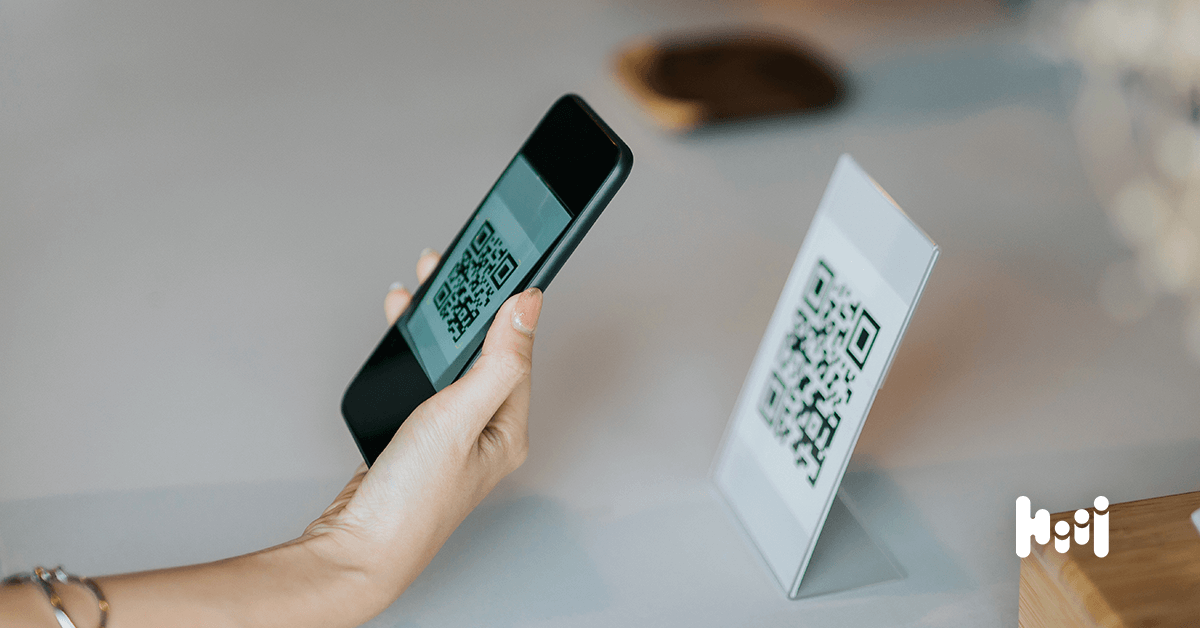
QR codes are divisive. Want to see for yourself? Head to your local coffee shop.
If it’s anything like mine, two order options will be available. The first? To get up and walk to the counter. The old-fashioned way if you will. The second is to whip out your smartphone, scan the QR code attached to the table (now a permanent fixture), make your order—mine’s an oat milk vanilla latte, thanks for asking—and have your drink brought to you.
From this rudimentary, caffeine-fueled research, I’ve discovered that QR codes are contentious. Some actively rebel against using them, preferring to head up to the counter and interact with a human being. Others adore the convenience and vow to never rise from their seat while dining out again.
Pre-pandemic, these obscure monochrome squares were rarely seen. In fact, they were actively frowned upon. In 2015, TechCrunch described them as “a scarlet letter, outing brands as being out of touch with technology.” Fast forward to 2022, after an epic comeback during a time when touchless interaction was key, QR codes are now everywhere. In August 2021, Bitly reported a 750% increase in QR code downloads over the previous 18 months.
But they’re not only useful for scoring your caffeine fix. Using QR codes in business can help to generate leads, improve customer experiences, and much more.
What Is a QR Code and How Does It Work?
The “QR” in QR code stands for “Quick Response,” as the collection of black squares and dots in each code represents a ton of information that is translated in mere seconds to readable data when you scan each code. QR codes are a souped-up version of the traditional barcode you see in the grocery store, with the ability to store far more information.
Where Did QR Codes Come From?
QR codes were born out of frustration with inefficiency over two decades ago. Working at car part manufacturer Denso, Hara Masahiro was determined to find a better way to keep track of parts in the factory than by scanning multiple bar codes. With the ability to imbed 200 times more information than a standard bar code, QR codes served as the perfect solution.
Masahiro’s gem of an idea was brought to life by the Denso development team, but due to limited resource they opened the patents in the hopes of others using and developing them. And the rest, as they say, is history.
Best Business Use Cases of QR Codes
By now, you’re probably used to seeing QR codes in your everyday life. But they’re not only helpful in consumer settings—QR codes can be beneficial for B2B businesses too. Below are some of the best business use cases of QR codes.
Boost Tradeshow Lead Capture
Measuring the effectiveness of a tradeshow has always been a tricky area for B2B sales and marketing teams. But when parting with a significant chunk of your budget, tracking ROI is essential. This is where QR codes can help, especially if lead generation is your main goal. Scanning badges is a common tradeshow lead generation tactic, but it has flaws. It can feel awkward to scan someone’s badge when conversation is flowing and is often only remembered when it’s too late and the prospect has walked away. It also relies on staff being available to chat. If your stand is rammed, there is potential for lost opportunities.
QR codes can multiply chances for lead capture, lessening reliance on badge scans. First, consider adding them to your pre-event promotional materials. This is obviously too soon to try and generate leads—the event hasn’t even happened yet! Instead, link the QR code to a map providing easy navigation to your space in the event hall. Use this as an opportunity to encourage more people to visit your booth by offering an incentive, exclusive to those who’ve found you via the code. A special piece of swag beyond the usual pens and tote bags can be simple, yet effective.
Use this tactic in-booth too. To generate more leads, promote a contest requiring users to scan a QR code and submit their details to enter a prize draw. Given the prize will be people’s main motivation for parting with their details, don’t follow up with a hard sell. Manage expectations of how quickly these leads are likely to convert (and how many of them) and opt for a gentle nurture campaign instead.

Supercharge Business Cards
Call them old-fashioned, but business cards remain a staple in the business world. Ten billion are produced every single year. Unfortunately, 88% of them are thrown out within a week. It’s unclear how many of those tossed cards had their information transferred to a digital device, but the odds aren’t looking good. Give your business cards a fighting chance by including a handy QR code that creates a new contact in the recipient’s phone. Reducing the effort it takes to physically input details may prevent your business cards from going to waste.
Measure Effectiveness of Out-of-Home Advertising
It’s notoriously difficult to measure the impact of Out-of-Home (OOH) advertising. QR codes aren’t a magic fix for this problem. But they can help, especially if used in areas with high dwell time, a.k.a., places where people are hanging around for a while, such as bus shelters. It’s unlikely you’re going to generate leads directly from a QR code, but it can help you measure your campaign. Simply have the code link to a dedicated landing page and you’ll be able to track how many people saw your ad and felt compelled enough to scan the QR code. On its own, this data may not tell you much. But if you run multiple OOH ads in various locations, the number of QR code scans on each one can indicate which locations perform better than others. Knowing this information can help you refine your approach, tailoring your campaign to the best-performing options. A word of advice; don’t forget to take cell service into account if you’re adopting this approach. If your ads are underground—on the subway for example—QR codes probably aren’t right for you.
Create More Customer Feedback Opportunities
Getting customer feedback can be challenging. Especially positive feedback. So, why not make it easier for your customers? When sending printed materials to your customers, take the opportunity to include a QR code linking to a customer satisfaction survey. Incentivizing them can help add an extra element of persuasion, even if it’s to receive something small or to enter them in a prize draw for an Amazon voucher, for example. Case studies are gold dust in B2B marketing and adopting this method may help you uncover customers that are ripe for a case study subject.
Personalize Customer Onboarding
Winning a new customer is worth celebrating, but don’t rest on your laurels once contracts are signed. Continue to impress them throughout the sign-on process by using QR codes to add a personal touch to your onboarding materials. If you’re sending out any contracts or partnership information in the mail, consider adding a QR code linking to a personalized video from their dedicated Account Manager. Use these videos as an informal introduction if the two parties are yet to meet and be sure to reinforce how delighted you are to welcome them onboard. Little touches like this can vastly improve the customer experience. Of course, this approach isn’t exclusive to onboarding, personalized videos can be used throughout the customer journey.
These are just some of the ways to implement QR codes in business settings. Like anything, the best use cases for you will be the ones that align best with your goals. You must also consider the adoption of QR codes in the markets you’re operating in. Some markets are more familiar with them than others. For example, China, Japan, and India are already accustomed to using QR codes for payments.
How Not to Use QR Codes
Despite their benefits, QR codes can worsen the customer’s experience if used incorrectly. Avoid the following:
- Whatever you do, don’t send your QR code recipients to a page that isn’t optimized for mobile. They’re scanning with a mobile device after all.
- Don’t use QR codes on digital media. If people are viewing your website or reading your emails, they’re already interacting with your channels. A QR code in this instance is not intuitive.
- Avoid auto-play media on QR code landing pages. We all know how embarrassing it is to be caught off-guard by a loud sound unexpectedly emitting from our phones in public (TikTok, we’re looking at you…).
How to Create QR Codes
Generating QR codes is surprisingly simple. A quick Google search for “QR code generator” will reveal multiple sites enabling you to transform your URL into a ready-to-use QR code in seconds for free. However, if you’re looking for more sophisticated analytics to show how your QR codes perform and advanced options for sizing and styling, you’ll probably need to sign up for a paid service.
QR Codes: More Than Just a Lead Generation Tool
Hopefully this post has shown you that QR codes are a versatile tool, with their usefulness extending far beyond just lead generation. However, if lead generation remains your main business challenge, we’ve got you. DemandScience’s solutions can help you not just generate leads, but convert them too, thanks to solutions such as SDR-as-a-Service.











